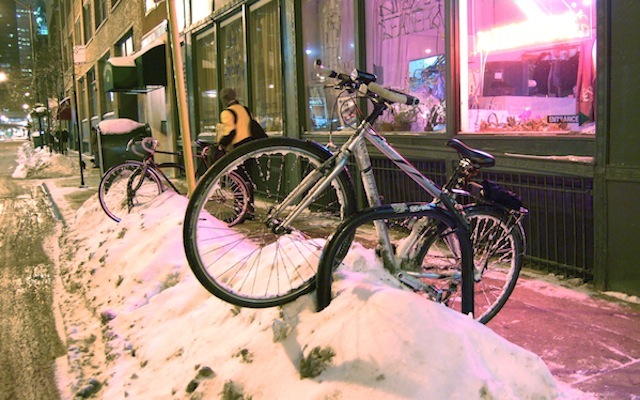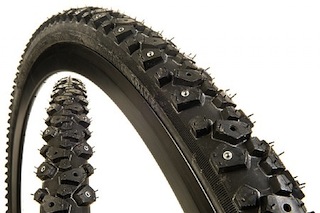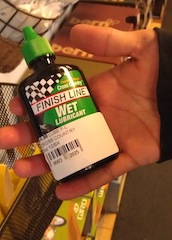The Chicagoist Winter Bike Guide (Part 1: Readying Your Ride)
By Kim Bellware in News on Dec 19, 2011 9:30PM

Deck your winter ride with lights, ideally so you have 360 degree visibility (image credit: Eric Allix Rogers)
Biking is wonderful. Chicago is wonderful. Therefore, biking in Chicago is pretty wonderful, right? Usually. But despite the miles of bike lanes, scenic streets and robust cycling community, any Chicago biking benefit becomes an afterthought once the first snowflake hits the ground.
Winter biking isn't just for the hard-core cyclists, and once you know the lay of things, it's a much easier undertaking than you may think. Biking the city in winter is not just hugely rewarding, it can also help you stay healthy, expose you to SADS-busting sunlight and give you freedom from overcrowded El trains and winter parking ban tickets.
In this two-part series, we'll help you prep your bike and body for winter riding in the city. It may seem like a lot of info, but biking happily and safely in the city during the winter months is part common sense and part stuff you should be doing anyway (like basic maintenance). If you have a question we didn't cover, leave it in the comments and we'll get it squared away.
Ok. Let's ride.
Readying Your Ride
They way you outfit your bike for the winter doesn't change much until the "wintry mix"—snow, sleet and ice—rears its head.
Fenders are an obvious must in the winter for keeping you clean and (relatively) dry. Lacking a rear fender will be more noticeable due to the "skunk stripe" that develops from your wheels churning up road slush, but both front and rear fenders are recommended if your bike doesn't come with them already. (Certain track bikes don't have the clearance for fenders, but you can also ask yourself why you're riding a track bike through slush).
Unless you ride a mountain or hybrid bike, tire width is one area you can change up for winter riding to have more control. Alejandro Barrios of West Town Bikes/Ciclo Urbano suggests using the widest tire your rims can handle if you normally ride on skinny tires. The average road bike tire is about 23 mm wide; Barrios said a larger tire will roll over snow while giving the rider some control. Tires that are closer to 32 mm, however, might be too wide to cut through snow leaving you spinning your wheels.
Pete, one of our favorite longtime mechanics and winter bike riders at Uptown Bikes, also suggests a slightly lower tire pressure to give you more contact with the road.
"Most bikes give the maximum pressure but not the minimum, so if your tire doesn't say, you can go down about 10 pounds lower than your max pressure," says Pete. "But also beware that if your pressure is lower, you're more susceptible to pinch flats."

An example of studded bike tires
"Studded tires will run you about $70 apiece, so they are an investment," says Pete.
Gizmodo shows how you can use zip ties as an inexpensive way to stud your tires and give you more slip control, though Pete cautions using them only if you have disc or drum brakes. "These won't work so well on brakes that touch the rim," says Pete. "You'll do some damage to caliper-style brakes."
No matter what you do to improve grip, wet metal surfaces are dangerously slick. There's no shame in dismounting and walking your bike over metal grates, bridges and slats.
Road Safety
Year-round, you'll want to ride with lights when it's dark out which, for many commuters, includes the early a.m. route to work as well as at night. Typically, a high-intensity strobe on the front (in white) and a tail light in the back (in red) will serve you well and make it easy for cars, pedestrians and other bikers to see you. If you can attach any lights to your sides or your helmet (so cars can see where you're turning your head) it only improves your level of visibility to other traffic. Eyes are attracted to movement, so use the blinking or strobe setting if your lights have that feature. Spoke reflectors and reflective tape and stickers can also help for making the sides of your bike easier to spot at night or in foggy conditions.
Unfortunately for bikers and drivers, the streets get considerably more narrow thanks to plow build-up that freezes into immovable snow drifts that last well into spring. For bikers, that usually means the narrowing—if not total loss—of designated bike lanes and shared lanes.
Pete notes that by Illinois law, motorists can't come within three feet of a cyclist.
"That's about the distance of your outstretched arm," says Pete. "You should take the space you need to ride safely and without slipping."
According to Pete, mirrors can also help. "When you can see what traffic is like behind you, you can make a more intelligent decision about how much of the lane to take up," he explains.
Maintaining Your Winter Bike
Bikes take a beating in the winter, which is why some riders purchase a second, less expensive bike to ride in the colder months. Winter is one of the best times to pick up bikes on sale; most shops put the current year's models on sale and post offers to keep customers coming in during the slow season.

West Town Bike's Alejandro Barrios recommends Finish Line for a thicker, longer lasting bike lube in winter (Chicagoist/Kim Bellware)
But even if you pick up a beater, you still have to give your bike a little extra care in the winter. Both Barrios and Pete suggest a weekly basic cleaning to remove grime, salt and other build up. Barrios recommends cleaning your bike chain and drivetrain with a runny liquid cleaner (he suggests the Rock n Roll brand for cleaning), followed by a thicker, more viscous lube such as Finish Line brand lubricant. He also says to pay attention to the spoke nipples to be sure they aren't rusting or corroding.
"You want something thicker that will stick through the winter weather," says Barrios. "And do not use WD-40; it's not meant for bikes."
Steel rims, which some say are more slick, will corrode faster than aluminum ones, though Barrios says simple cleaning once a week should stave off problems.
Storing your bike inside also helps lessen the winter wear-and-tear, even if it's just overnight. In addition to giving a wet bike a chance to drip dry, stashing your bike someplace above freezing will prolong its life.
"You want to get your bike inside because grease starts to coagulate and gum the bike up," Pete explains. "A freewheel or cassette hub has little balls inside with springs or legs, and below 20 degrees they can get seized in the down position and your chain will stick and not move. It's not always a problem, but if those components are worn out, storing your bike in the cold will push it over the edge."

West Town Bike's winter maintenance punch card (Chicagoist/Kim Bellware)
Salt, plows and parking
Whether the roads are plowed or covered in a freshly fallen snow, nearly everyone we talked to said simply slowing down can help you stay safe (and upright) on your bike in the winter.
Cyclists generally don't have to ride through much snow if they stick to arterial and main streets. Arterial and main streets get plowed first, followed by side streets (sometimes). If for whatever reasons you like riding in alleys, you're out of luck: the next time you'll see alley pavement is spring time. Even though they're cleared less frequently, some cyclists prefer side streets due to less traffic congestion.
With plowed streets comes lots of salt. The biggest threat salt poses is the havoc in can wreak on your bike's metal components, but large patches of salt (where it looks like the truck stopped and dumped crystals all over the road) can making for a braking hazard; just slow down or dismount. Also, with salt comes roughed-up pavement, so slow down and be aware for potholes where there were no potholes before. If you spot a real doozy, just like motorists, you can report potholes to 311.
Slush can be tricky, so don't hesitate to take more of the lane if you think you'll be unsafe closer to the sidewalk. With notoriously poor drainage, you can count on big puddles around corners, so give yourself plenty of time to brake, and be on the lookout for cars that could splash you.
When parking your bike, avoid utility poles or any anchor that's close to the sidewalk lest your precious ride be buried-or worse-crushed.
Did we miss anything? Let us know in the comments, and check back Wednesday for Part 2: Dress for Success.
Special thanks to West Town Bikes/Ciclo Urbano, Uptown Bikes and Copenhagen Cyclery
